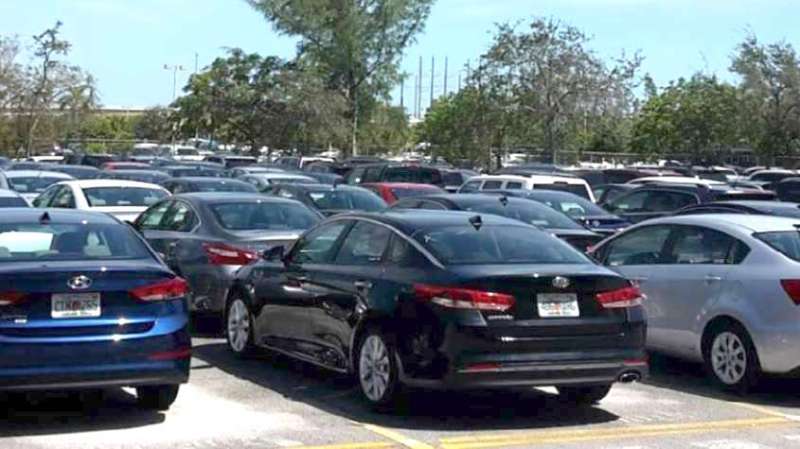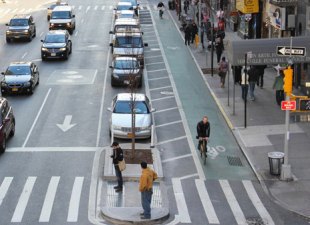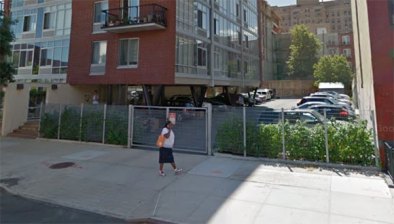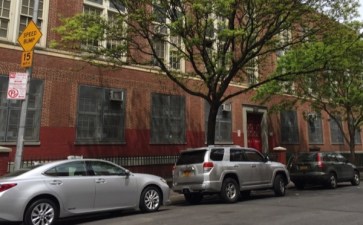Op-Ed: To Break the Car Culture, Reduce the Number of Parking Spots
There is basically a space for every licensed driver in the city. How to get rid of them now.

New Yorkers who are agitating for safe streets understand that our large reservoir of free or underpriced parking provides a huge subsidy to vehicle owners. They also know that any strategy to break the “car culture” here must reduce the number of available car-storage spots.

Our leaders — or, at least, some of them — understand this, too. Council Speaker Corey Johnson, in his “Let’s Go” report, recently called for reducing the number of private vehicles in the city by half by 2050 — and noted that the city has “too many parking spaces” (bringing condemnation on himself from the car-loving minority).
Before we can consider how many spaces we must remove, we need to know how many spaces we have.
Department of Transportation Commissioner Polly Trottenberg recently testified that the city holds 3 million free curbside parking spaces — but that estimate grossly understates the total number of all kinds of spaces available, whether public, private, in parking lots, etc. In fact, I estimate that the city has 5,377,375 parking spaces — basically, a space for each of the 5.6 million city residents with a driver’s license.
If we want to reduce vehicle use, we must consider all space dedicated to car storage, not just the on-street parking managed by DOT. Then we can amend our land-use, zoning, and on-street-parking policies to eliminate spaces and curtail their creation — fostering a vision of a life centered around people, not cars.
Where do we currently store cars?
Basically, everywhere:
- Curbside car storage: Our curbs have been given over to cars since the 1920s. Metered parking, unmetered parking, commercial parking, police parking, loading zones, and even “no parking” — all are legal for one driver or another to park a vehicle. It’s hard to remember that overnight car storage wasn’t even allowed on city streets until the summer of 1950!
- Parking garages: These businesses sell parking on an hourly, daily, or monthly rate, under license by the Department of Consumer Affairs.
- Parking lots: City-mandated parking fields for customers and/or employees surround malls, big-box stores, and office parks. These came about because of zoning.
- Private parking: Driveways, attached garages, detached garages and resident-only or employee-only lots, like those of stores, often owe their creation to city required parking minimums.
The city directly controls curbside parking, so it’s the most easily reformed (if political will can be summoned!). But the outer boroughs have much more parking in private hands — much of it in detached garages and driveways or in the parking lots of stores and offices.
For an idea of the tremendous waste of space this entails, consider: The combined spaces in detached parking garages could fill Central Park two deep, with some left over. Parking lots for city stores and offices, meanwhile, contain spaces for more than a million cars, a capacity that is three times greater than all the paid parking garages here combined. The 377 million square feet these parking lots cover equals the space of 10 Central Parks!
Some strategies
A plan to curtail parking would combine land-use and parking-management policies, including the following:
End parking-minimum restrictions: One dramatic way to reduce parking would be for the city (and the state) immediately to outlaw zoning rules that require builders to construct a certain number of parking spaces. Indeed, ending these requirements on builders is key to developing walkable cities.
Removing “parking-minimum restrictions” doesn’t mean that new parking won’t be built, but it does ensure that developers won’t over-build parking and forces the choice of paying for parking spaces onto buyers and tenants.
Speed is critical here. About half of our parking capacity is affected by zoning. The parking garages in use today were built over many years; developments are often multi-year projects. Because land-use changes so slowly, zoning changes must happen quickly if we want to see any effect in the coming decades.
Institute transit-oriented-development parking maximums: Parking maximums limit the number of spaces in residential or commercial developments, usually by the number of housing units or retail square footage. It’s especially important to restrict parking near subways and other dense transit, such as high-frequency bus routes or bike lanes. Ideally, the parking maximum in a dense area would be zero — for example, a new tower built a block from Union Square wouldn’t include a parking garage.
Promote transit-oriented up-zoning: Transit oriented up-zoning should accompany parking-zoning changes, in order to shift a majority of new housing and commercial spaces to locations that are less car-dependent. The city should set a height minimum of five stories for all new construction within a half mile of a subway or high-frequency bus stop. In transit-dense areas served by multiple subway lines, the minimum height should be 20 stories.
Expand metered parking: Parking meters should regulate the curbs 24/7 where space is at a premium. For example, free parking should not exist at any time of day near Times Square, with its multi-unit residences and many businesses, or near many commercial zones. In those locations, it is spatially impossible for everyone to have a car, so we need to price parking at market rates — at a minimum.
The City Council should reverse its 2005 edict requiring that metered parking spots remain free of charge 15 percent of the time. The council should rescind the restriction on metered parking on Sunday — charging for parking just like it does on Saturdays or Tuesdays.
Repurpose on-street car storage spaces: Finally, the city should aggressively repurpose parking spaces as protected bike lanes, bus-only lanes, or green spaces or just remove the parking altogether. These are all ways to promote people over 3,000-pound, steel-and-plastic machines.
So, if we were to eliminate half of the city’s parking spaces in order to support Johnson’s goal of lessening the number of cars by half, how many would that be?
DOT would need to remove 3,900 on-street parking spaces every month for 31 years in order to accomplish that. It would take the removal of 12,500 spaces every month to accomplish the goal in 10 years.
It sounds like a lot, and it is. Proposals to reduce parking require advocates with guts and fortitude, because many of their opponents suffer from “parking psychosis” — a condition in which entitled drivers believe that the city owes them lifetime free car storage in the public right of way. Witness the reaction of certain Central Park West residents, who sued the city to stop it from removing 400 parking spaces in order to build a protected bike lane.
But as it is now, driving in New York is cheap, and it’s killing us. Cars not only clog our curbs, they congest our streets, mow us down, and pollute our air. They have to go — and the first step is kicking them from the curb.





